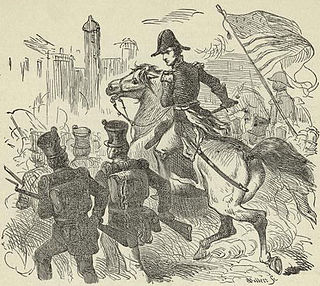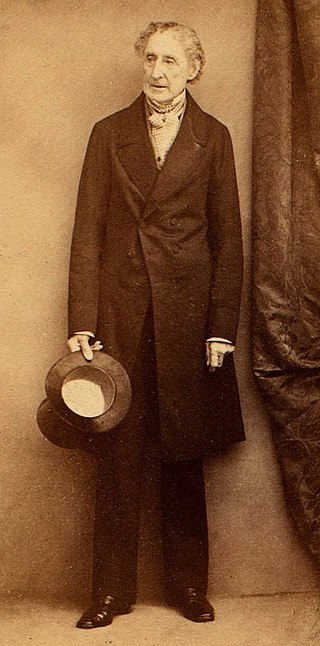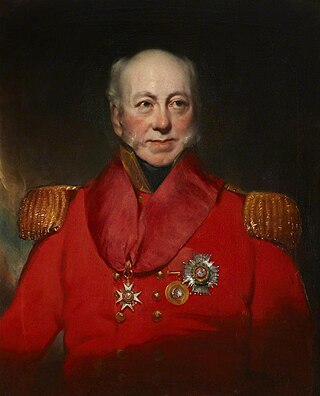
The Battle of New Orleans was fought on January 8, 1815, between the British Army under Major General Sir Edward Pakenham and the United States Army under Brevet Major General Andrew Jackson, roughly 5 miles (8 km) southeast of the French Quarter of New Orleans, in the current suburb of Chalmette, Louisiana.

Major General Sir Edward Michael Pakenham,, was an Anglo-Irish Army officer and politician. He was the son of the Baron Longford and the brother-in-law of the Duke of Wellington, with whom he served in the Peninsular War. During the War of 1812, he was the commander of British forces attempting to take the Southern port of New Orleans (1814–15). On 8 January 1815, Pakenham was killed in action while leading his men at the Battle of New Orleans.

Admiral Sir Alexander Inglis Cochrane was a senior Royal Navy commander during the Napoleonic Wars and achieved the rank of admiral of the blue.

The Battle of Baltimore took place between British and American forces in the War of 1812. American forces repulsed sea and land invasions off the busy port city of Baltimore, Maryland, and killed the commander of the invading British forces.

Field Marshal Sir John Fox Burgoyne, 1st Baronet, was a British Army officer. After taking part in the Siege of Malta during the French Revolutionary Wars, he saw action under Sir John Moore and then under the Duke of Wellington in numerous battles of the Peninsular War, including the Siege of Badajoz and the Battle of Vitoria. He served under Sir Edward Pakenham as chief engineer during the War of 1812. He went on to act as official advisor to Lord Raglan during the Crimean War advocating the Bay of Kalamita as the point of disembarkation for allied forces and recommending a Siege of Sevastopol from the south side rather than a coup de main, so consigning the allied forces to a winter in the field in 1854.

The Battle of Pensacola took place during the Creek War, part of the War of 1812, in which American forces fought against forces from the kingdoms of Britain and Spain who were aided by the Creek Indians and African-American slaves allied with the British. General Andrew Jackson led his infantry against British and Spanish forces controlling the city of Pensacola in Spanish Florida. Allied forces abandoned the city, and the remaining Spanish forces surrendered to Jackson.

HMS Starr was a 16-gun Merlin-class ship sloop of the Royal Navy. She was built by Tanner, of Dartmouth, to plans by Sir William Rule, and launched in July 1805. As a sloop she served on convoy duty, though she also participated in the invasion of Martinique in early 1809. She was rebuilt as a bomb vessel in May 1812 and renamed Meteor. As Meteor she served in the Baltic and then off the United States, participating in attacks on up the Potomac and on Baltimore and New Orleans. She was sold in October 1816.

Lieutenant-General Sir Manley Power, KCB, ComTE was a British military leader who fought in a number of campaigns for Britain and rose to the rank of Lieutenant-General. He is chiefly remembered for leading a brigade of Portuguese troops under The Duke of Wellington in the Iberian Peninsular War. He is also remembered for jointly causing the removal of Sir George Prévost, governor-in-chief of British North America, for Prevost's refusal to press the attack on Plattsburgh, New York, in 1814, during the War of 1812. After his active military service Sir Manley Power was appointed Lieutenant Governor of Malta.
The 85th Regiment of Foot was a British Army line infantry regiment, raised in 1793. Under the Childers Reforms it amalgamated with the 53rd (Shropshire) Regiment of Foot to form the King's Shropshire Light Infantry in 1881.

Field Marshal Sir Edward Blakeney was a British Army officer. After serving as a junior officer with the expedition to Dutch Guiana and being taken prisoner by privateers three times suffering great hardship, he took part in the Anglo-Russian invasion of Holland in 1799. He also joined the expedition to Denmark led by Lord Cathcart in 1807. He went on to command the 2nd Battalion of the 7th Regiment of Foot and then both battalions of that regiment at many of the battles of the Peninsular War. After joining the Duke of Wellington as he marched into Paris in 1815, Blakeney fought in the War of 1812. He then commanded a brigade in the army sent on a mission to Portugal to support the constitutional government against the absolutist forces of Dom Miguel in 1826. His last major appointment was as Commander-in-Chief, Ireland, a post he held for nearly twenty years.
Thomas Mullins was a British Army officer of the 44th Regiment of Foot, best known for his misconduct at the Battle of New Orleans during the War of 1812. While he performed well during the Chesapeake campaign, his failure to check on the regiment's engineering supplies at New Orleans played a key role in the disorganization and subsequent defeat of the British there.
Fort Bowyer was a short-lived earthen and stockade fortification that the United States Army erected in 1813 on Mobile Point, near the mouth of Mobile Bay in what is now Baldwin County, Alabama, but then was part of the Mississippi Territory. The British twice attacked the fort during the War of 1812.

The Battle of Lake Borgne was a coastal engagement between the Royal Navy and the U.S. Navy in the American South theatre of the War of 1812. It occurred on December 14, 1814 on Lake Borgne. The British victory allowed them to disembark their troops unhindered nine days later and to launch an offensive upon New Orleans on land.

The siege of Fort St. Philip was a ten day long distance bombardment of exploding bomb shells - by two Royal Navy bomb vessels, mounting a total of four mortars - against the American garrison of Fort St. Philip. The fort was unable to retaliate at the start, as the bomb vessels were out or the range of its solid shot cannon, and its mortar did not have ammunition. This was remedied by supply boats, whereby the fort counter-attacked the bomb vessels with its mortar on January 17, and the British duly withdrew. This riverine engagement took place during the concluding hostilities of the War of 1812.

General Sir Frederick Stovin was a British Army officer who served throughout the Napoleonic Wars and the War of 1812. After the end of the wars, he commanded colonial garrisons and served in administrative roles in Ireland, before retiring with the rank of colonel to take up a position at court as a Groom in Waiting under Queen Victoria. In retirement, he continued to rise through the ranks of general officers by seniority, dying a full general.

Sir Arthur Brooke KCB was an Irish officer of the British Army during the French Revolutionary and Napoleonic Wars, and the Peninsular War and War of 1812. He rose to the rank of lieutenant-general.
Lieutenant General Sir William Thornton KCB was a British Army officer who served as Lieutenant Governor of Jersey.
Major General John Robyns, was a senior officer of the Royal Marines who served during the French Revolutionary Wars and earned historically noteworthy military distinctions on the North America and West Indies Station during the Napoleonic Wars and the War of 1812. As a battalion commander of Royal Marines, Captain John Robyns faced enemy forces which included his counterparts of the United States Marines at Bladensburg, Washington, Baltimore, and New Orleans. In his later years Robyns served one term as Mayor of Penzance (1840–41) in his native Cornwall.
HMS Statira was a Lively-class fifth-rate 38-gun sailing frigate of the British Royal Navy, built during the Napoleonic Wars.

SirSamuel Gibbs (1770–1815) was an English officer in the British Army during the Napoleonic Wars and the War of 1812, rising to the rank of major-general. Gibbs was second-in-command under Edward Pakenham at the Battle of New Orleans and died of wounds received while leading one of the main columns in the failed British assault.













